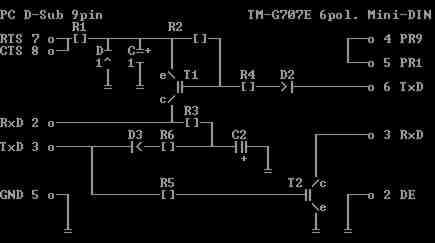

TM-V7(E)
----------
UP ---+------------------+
| |
PF3 +100K+--o/o--------+
| |
PF4 +22k+---o/o--------+
|
8V -> frei/free/libre |
|
GND(masse)---------------+--o/o---+
| |
DWN---+------------------+ |
| | |
PF1 +100K+--o/o--------+ |
| | |
PF2 +22K+---o/o--------+ |
|
STBY(ptt)-------------------------+---> PTT
GND(mic)------o/o----
Mic 600ohm
MIC------------------/
NC:-> frei/free/libre
Legende:
o/o = Schalter oder Taster / switch / bouton ou interrupteur


NOTE: This is not a copy of the existing PG-4S cable but a replacement designed by DB8KY.
One of the most handy things about this transceiver is: you can program this transceiver by computer. You can download the software from the Kenwood site but there no datasheet of the PG-4S cable which you require. I found a datasheet which replace the PG-4S cable and is designed by DB8KY. I made this cable and it works fine on my transceiver.The manual is written in German by DB8KY. He said he never tried this cable on a TM-V7, but it works very good on my transceiver. So here below you will see the instructions.
Have fun! PE1PTS
Der Kenwood TM-G707E ist ja ein schoenes Geraet und
die Vergabe von Speichernamen ein nettes Feature, wenn man das alles nur vom
Rechner aus programmieren koennte...
Kann man, die Software dazu steht
bei Kenwood auf der Web-Seite, dann fehlt nur das Kabel zum Anschluss an den
Rechner. Ich habe zwar keine Ahnung was sich in dem original PG-4S Kabel von
Kenwood abspielt, wenn man den TM-G707E aber in den Clone-Mode versetzt und sich
mal die Signale auf der Mini-DIN Buchse ansieht wird klar, dass es sich bei der
Elektronik im Kabel um einen TTL/RS232-Wandler handeln muss. Die unten
dargestellte Schaltung erfuellt diese Aufgabe bei mir jedenfalls klaglos. Ich
denke das ganze funktioniert auch am TM-V7E.
Wie funktioniert es:
Die
Verbindung zwischen Pin 4 und 5 benoetigt der Kenwood wohl um von FSK auf
seriellen Betrieb umzuschalten. Das Signal vom PC zieht ueber R5 mit T2 den
RxD-Eingang am Kenwood low, hier ist intern offensichtlich bereits ein
Pull-up
Widerstand vorhanden. Schwieriger ist der Weg vom Kenwood zum PC,
der Kenwood gibt nur ein TTL-Signal aus, der serielle Eingang am PC will aber
+/- ca. 10V sehen. Also muessen zwei Hilfsspannungen gewonnen werden. Aus dem
RTS-Signal
des PC wird ueber R1 eine positive Spannung gewonnen und mit D1
und C1 stabilisiert. Aus dem TxD-Signal des PC wird ueber D3 und R6 dann noch
eine negative Spannung gewonnen und mit C2 gepuffert. Dann kann der Kenwood mit
den Sendedaten ueber T1 jetzt zwischen der positiven und negativen Spannung
umschalten.
Ich habe das ganze in den Sub-D Stecker
reingefummelt.
Viel Spass damit wuenscht Wulf, DB8KY
DB8KY
@DB0RWI.#NRW.DEU.EU
(Wer das nachbaut tut es auf seine eigene
Verantwortung)
PC D-Sub 9pin TM-G707E 6pol. Mini-DIN

R1/R6 = 150 Ohm
R2 22 kOhm
R3 10 kOhm
R4 33 kOhm
R5
15 kOhm
C1/C2 = 1uF/16V Elko
D1 = Z-Diode 5,1 Volt
D2/D3 = 1N4148 oder
aehnlich
T1 = BC558A oder aehnlich
T2 = BC337 oder aehnlich
For an English Interpretation, visit KC7ZRU's pages. Includes RS part numbers, re-drawn schematic and user comments.
